Mount
Grace
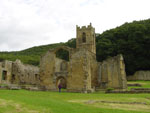 The
single manuscript of The Book of Margery Kempe is marked "Liber Montis
Gracie: This boke is of Mountgrace" on a binding leaf. At some time
before the dissolution of the monastery in 1539, this copy of the manuscript
was in the possession of the Carthusian
monks of Mount Grace Priory in northern Yorkshire. A Carthusian hand
annotated the manuscript, so that we can ascertain the book was read and
valued as a spiritual treatise by probably the most respected of contemplatives
of their time. The
single manuscript of The Book of Margery Kempe is marked "Liber Montis
Gracie: This boke is of Mountgrace" on a binding leaf. At some time
before the dissolution of the monastery in 1539, this copy of the manuscript
was in the possession of the Carthusian
monks of Mount Grace Priory in northern Yorkshire. A Carthusian hand
annotated the manuscript, so that we can ascertain the book was read and
valued as a spiritual treatise by probably the most respected of contemplatives
of their time.
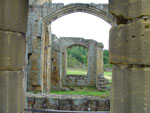 Based
on the guidebook by Glyn Coppack , English Heritage publications for Mount
Grace Priory Based
on the guidebook by Glyn Coppack , English Heritage publications for Mount
Grace Priory
Mount Grace Priory, second only to London in repute, is the best preserved
and most accessible of the ten Carthusian charterhouses in England. Founded
in 1398 by Thomas de Holand, Earl of Kent and Duke of Surrey, the house
was part of a revival of spirituality in the latter Middle Ages that began
with the founding of the London charterhouse in 1371 on the site of the
plague cemetery and culminated in the royal charterhouse of Sheen in 1415.
In every case the founder was from the highest levels of society and monks
were also drawn from the literate upper levels as well. Many Carthusians
began their lives as secular priests, university scholars, or members
of other orders.
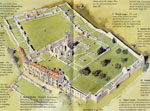 In
1539 Mount Grace closed under the edict of Henry VIII that established
the sovereign as head of the Church and severed links with monastic orders
on the continent. Destruction of the Carthusian congregation in England
began before the general Suppression, and can be traced back to the order's
refusal to accept the Act ofSuccession of 1534 by which Henry VIII legitimized
his seco In
1539 Mount Grace closed under the edict of Henry VIII that established
the sovereign as head of the Church and severed links with monastic orders
on the continent. Destruction of the Carthusian congregation in England
began before the general Suppression, and can be traced back to the order's
refusal to accept the Act ofSuccession of 1534 by which Henry VIII legitimized
his seco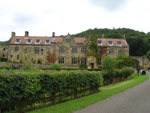 nd
marriage despite the Pope's refusal to annul the first. Opposition to
the oath was led by Prior John Houghton of the London charterhouse. In
May 1535, Houghton and two other Carthusian priors were tried for treason
and executed at Tyburn in London. Faced with such brutality, Prior Wilson
of Mount Grace, pressured by the Archbishop of York and Bishop of Durham,
signed the Act. Similar to other monastic sites, in 1654, Mount Grace's
guest areas were converted to a domestic residence. They now serve as
the site of the museum and other offices. nd
marriage despite the Pope's refusal to annul the first. Opposition to
the oath was led by Prior John Houghton of the London charterhouse. In
May 1535, Houghton and two other Carthusian priors were tried for treason
and executed at Tyburn in London. Faced with such brutality, Prior Wilson
of Mount Grace, pressured by the Archbishop of York and Bishop of Durham,
signed the Act. Similar to other monastic sites, in 1654, Mount Grace's
guest areas were converted to a domestic residence. They now serve as
the site of the museum and other offices.
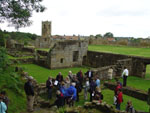 Carthusians
were founded by St.
Bruno (1030-1101) as part of a general reform of western monasticism
of the 11th century. Bruno was born at Cologne and for about twenty years,
from 1057 to 1075, directed the theological school at Reims until he and
several companions withdrew to a remote area in the Alps of Dauphiné
named Chartreuse in 1088. Carthusians arrived in England from this monastery
(the Grande Chartreuse) in 1178-79 at the invitation of Henry II who had
agreed to found several new monasteries in penance for his part in the
death of Thomas
Becket. Carthusians
were founded by St.
Bruno (1030-1101) as part of a general reform of western monasticism
of the 11th century. Bruno was born at Cologne and for about twenty years,
from 1057 to 1075, directed the theological school at Reims until he and
several companions withdrew to a remote area in the Alps of Dauphiné
named Chartreuse in 1088. Carthusians arrived in England from this monastery
(the Grande Chartreuse) in 1178-79 at the invitation of Henry II who had
agreed to found several new monasteries in penance for his part in the
death of Thomas
Becket.
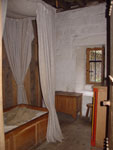 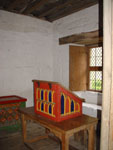 The
life combined the eremitical and cenobite (communal) forms of monasticism
although the Customs (Rule) of Chartreuse were not committed to writing
till 1127. Unlike most other monks, who lived in common, the Carthusians
lived as hermits, each occupying his own cell and coming together only
at certain fixed times in church. Mount Grace has been carefully excavated
and much of the daily life of a Carthusian ascertained by the findings.
Twelve individuals "cells" or little cottages are clustered
around a great cloister. Mount Grace's cells contained three rooms on
the first floor (bedroom, study, and parlor) with a stair leading to a
large open workroom above. Each cottage had its own enclosed garden to
the rear, and most significantly a latrine with running water. Water supply
was one of the most sophisticated for its age, gravity driven, water The
life combined the eremitical and cenobite (communal) forms of monasticism
although the Customs (Rule) of Chartreuse were not committed to writing
till 1127. Unlike most other monks, who lived in common, the Carthusians
lived as hermits, each occupying his own cell and coming together only
at certain fixed times in church. Mount Grace has been carefully excavated
and much of the daily life of a Carthusian ascertained by the findings.
Twelve individuals "cells" or little cottages are clustered
around a great cloister. Mount Grace's cells contained three rooms on
the first floor (bedroom, study, and parlor) with a stair leading to a
large open workroom above. Each cottage had its own enclosed garden to
the rear, and most significantly a latrine with running water. Water supply
was one of the most sophisticated for its age, gravity driven, water 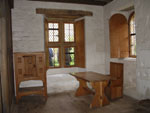 circulated
throughout the mona circulated
throughout the mona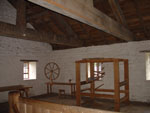 stery
including the water tower in the cloister's center,cooking areas, and
basins throughout as well as the lavatories. Hygiene and quality food
(although meatless) contributed to unusually long lives for many of these
monks. English Heritage recently rebuilt a cell showing its appearance
in the early 16th century, the furnishings are based on excavations and
on images in Carthusian manuscripts from the time. stery
including the water tower in the cloister's center,cooking areas, and
basins throughout as well as the lavatories. Hygiene and quality food
(although meatless) contributed to unusually long lives for many of these
monks. English Heritage recently rebuilt a cell showing its appearance
in the early 16th century, the furnishings are based on excavations and
on images in Carthusian manuscripts from the time.
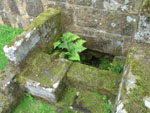 The
monks received their food and all contact with the outside world through
an opening in the cell wall. Evidence of book production was found in
the cells in the north west corner of The
monks received their food and all contact with the outside world through
an opening in the cell wall. Evidence of book production was found in
the cells in the north west corner of 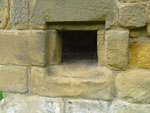 the
cloister, to the left of the reconstructed cell: one with pen nibs (for
the scribe), the other with paints (for the illuminator), and the third
with book binding materials. The Carthusians, despite their lives as hermits,
continued to exercise intellectual influence in their era. Nicholas
Love for example, wrote the widely circulated Mirror of the Blessed
Life of Jesus Christ, a vernacular treatise based directed to a lay readers the
cloister, to the left of the reconstructed cell: one with pen nibs (for
the scribe), the other with paints (for the illuminator), and the third
with book binding materials. The Carthusians, despite their lives as hermits,
continued to exercise intellectual influence in their era. Nicholas
Love for example, wrote the widely circulated Mirror of the Blessed
Life of Jesus Christ, a vernacular treatise based directed to a lay readers
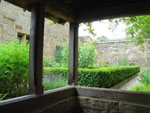 and
listeners. His tomb, noted here below the arch by the archeologist Glynn
Coppack, is unmarked, but located through historical evidence. and
listeners. His tomb, noted here below the arch by the archeologist Glynn
Coppack, is unmarked, but located through historical evidence.
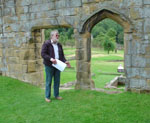 Carthusian
monasteries were seen as prestigious places for burial. The lavish and
often artistically groundbreaking decoration of Carthusian churches is
related to their attraction as particularly holy sites, where the exemplary
lives and prayers of the monks will benefit the souls of the dead. At
Mount Grace, the church shows evidence of rebuilding, a window blocked
in and walls heightened to give greater honor to the secular tomb in the
center. The Charterhouse in Cologne had an extensive early 16th-century
stained glass cycle, most destroyed in the secularization of the monasteries
in the early 19th century but some panels surviving such as the image
of Donor
Portrait of Prior Peter Blommeveen now in the Worcester Art Museum. Carthusian
monasteries were seen as prestigious places for burial. The lavish and
often artistically groundbreaking decoration of Carthusian churches is
related to their attraction as particularly holy sites, where the exemplary
lives and prayers of the monks will benefit the souls of the dead. At
Mount Grace, the church shows evidence of rebuilding, a window blocked
in and walls heightened to give greater honor to the secular tomb in the
center. The Charterhouse in Cologne had an extensive early 16th-century
stained glass cycle, most destroyed in the secularization of the monasteries
in the early 19th century but some panels surviving such as the image
of Donor
Portrait of Prior Peter Blommeveen now in the Worcester Art Museum.
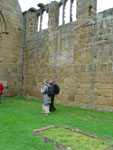 Some
of the best-known works of art associated with the Order are those of
the Chartreuse de Campmol, near Dijon, the burial site selected by Philip
the Bold, Duke of Burgundy 1363-1404. The portraits of Duke
and Duchess Some
of the best-known works of art associated with the Order are those of
the Chartreuse de Campmol, near Dijon, the burial site selected by Philip
the Bold, Duke of Burgundy 1363-1404. The portraits of Duke
and Duchess 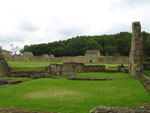 keeling
in prayer before the Virgin and Child by Claus
Sluter, considered the greatest sculptor of his time, appear on the
entrance portal of the church. Sluter also executed sculptures for the
cloister's central well (just as a well was at the center of Mount Grace's
cloister) called the Well
of Moses after its best known figure. The Duke also commissioned a
great altarpiece
(1394-99), whose wings show paintings of the Life of the Virgin by Melchior
Broederlam in incipient perspective. keeling
in prayer before the Virgin and Child by Claus
Sluter, considered the greatest sculptor of his time, appear on the
entrance portal of the church. Sluter also executed sculptures for the
cloister's central well (just as a well was at the center of Mount Grace's
cloister) called the Well
of Moses after its best known figure. The Duke also commissioned a
great altarpiece
(1394-99), whose wings show paintings of the Life of the Virgin by Melchior
Broederlam in incipient perspective.
See also David Knowles,
The Religious Orders in England, 3 vols., Cambridge University
Press: Cambridge, 1979.
Return
to Top of Page
|
